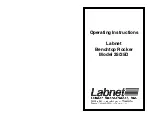
8
Product Description and Handling Instructions
If the equipment is inadvertently overloaded (trying
to raise a resident heavier than permitted), an
automatic ‘cut out’ operates to prevent the
Sara
3000
lifting a load in excess of the safe worki ng
load; this will stop the lift motion automatically.
“overload” occurs on Display and Buzzer beeps
continuously. If this automatic cut out occurs, the
electronics will reset when the button on the handset
is released. After this, the resident can be lowered,
by pressing the “lower” function button on the
handset. Remove the resident from the equipment.
Automatic Stop Function - for use when
Lowering:
(see Fig. 1) Great care shall be taken not
to lower the resident support arms onto the resident
or any other obstruction, particularly when the
resident is standing up and weight bearing. If this
shall happen, the motor will continue to run but
downward movement will be blocked by the
obstruction. If this occurs, release pressure from the
“lower” button immediately and operate the “raise”
button until the equipment is clear. Then remove the
obstruction.
OverHeat protection
:Buzzer will beep twice
every 15 seconds and “OverHeat” is displayed on
the Hour/Cycle Meter (see Fig. 1) when the
operator exceeds the duty cycle for the lift actuator
(2 minutes/18 minutes). When signal occurs
movement is still possible. The function protects
the actuator against damage.
System failure lower override:
This can be
used in the event of main control failure. In the
unlikely event that the hand control or dual control
feature fails to operate the
Sara 3000
, with a
resident still supported by the sling, provision for
lowering has been made, using the system failure
lower override, situated on the actuator, (see Figs. 1
& 3).
A label situated on the control collar is for quick and
easy recognition (see Fig. 3) To operate this
function, pull the slide control upwards until the
resident’s own weight enables the mast to slowly
lower. To cease lowering release the slide control.
Only use this function in the event of normal control
failure, do not use it for normal function lowering.
.
Battery Discharge Indicator:
(see Fig. 1) There
is a small battery symbol on the bottom of the LCD.
The battery symbol shows the level of battery
charge.
Hour /Cycle Meter:
(see Fig. 1) The upper line of
the display shows the total duration of lifting and
lowering operation in hours. The display can also
shows number of cycles by pressing the raise and
lowering buttons at the same time. This is intended
as an aid to help calculating the service intervals.
Chassis Castor Brakes:
The chassis rear
castors have brakes which can be foot operated if
required (see Fig. 4), to keep the
Sara 3000
in
position.
Foot Support:
For positioning before and
supporting the resident’s feet during raising and
transferring.
Lower Leg Straps:
Accessory used to ensure that
the lower parts of the resident’s legs stay close to the
knee support. They pass around the knee supports,
then around the resident’s lower calves. To fasten,
click the strap into it’s socket as with a seatbelt.
Ensure that the straps are firm but comfortable for
the resident.
Warning:
Before operating the “system
failure lower override” to lower a
resident, always ensure that a chair or
suitable support is underneath ready to
support the resident.
Fig. 3
Fig. 4











































